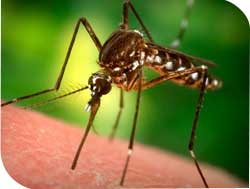
Mosquitoes

 Adult mosquitoes are small, fragile insects with slender bodies; one pair of narrow; and three pairs of long,
Adult mosquitoes are small, fragile insects with slender bodies; one pair of narrow; and three pairs of long,
slender legs
 They have an elongate "beak" or piercing proboscis
They have an elongate "beak" or piercing proboscis
 The mosquito goes through four separate and distinct stages of its life cycle: Egg, Larva, pupa, and adult
The mosquito goes through four separate and distinct stages of its life cycle: Egg, Larva, pupa, and adult
 There are three common groups of mosquitoes: Aedes, Anopheles and Culex
There are three common groups of mosquitoes: Aedes, Anopheles and Culex
AEDES MOSQUITOES

 Aedes mosquitoes have typical black and white stripe markings on their body and legs
Aedes mosquitoes have typical black and white stripe markings on their body and legs
 Eggs of these mosquitoes are laid singly or in rafts and although they may stick to the surface, they may sink
Eggs of these mosquitoes are laid singly or in rafts and although they may stick to the surface, they may sink
if the water is disturbed
 Aedes prefers clean water for the development of the larvae
Aedes prefers clean water for the development of the larvae
 Only the female aedes mosquito bites as it needs the protein in blood to develop its eggs.
Only the female aedes mosquito bites as it needs the protein in blood to develop its eggs.
 Peak biting is at dawn and dusk.
Peak biting is at dawn and dusk.
 The average lifespan of an Aedes mosquito is 2 weeks
The average lifespan of an Aedes mosquito is 2 weeks
 The mosquito can lay eggs about 3 times in its lifetime, and about 100 eggs are produced each time.
The mosquito can lay eggs about 3 times in its lifetime, and about 100 eggs are produced each time.
 The eggs can lie dormant in dry conditions for up to about 9 months, after which they can
The eggs can lie dormant in dry conditions for up to about 9 months, after which they can
if exposed to favourable conditions, i.e. water and food
 Responsible for transmitting dengue fever, encephalitis, and yellow fever
Responsible for transmitting dengue fever, encephalitis, and yellow fever
ANOPHELES MOSQUITOES

 Anopheles mosquitoes go through four stages in their life cycle: egg, larva, pupa, and adult
Anopheles mosquitoes go through four stages in their life cycle: egg, larva, pupa, and adult
 Eggs are laid singly directly on water and are unique in having floats on either side
Eggs are laid singly directly on water and are unique in having floats on either side
 Eggs are not resistant to drying and hatch within 2-3 days
Eggs are not resistant to drying and hatch within 2-3 days
 Anopheles mosquitoes can be distinguished from other mosquitoes by the palps, which are as long as
Anopheles mosquitoes can be distinguished from other mosquitoes by the palps, which are as long as
the proboscis, and by the presence of discrete blocks of black and white scales on the wings
 Typical resting position: males and females rest with their abdomens sticking up in the air
Typical resting position: males and females rest with their abdomens sticking up in the air
 Anopheles mosquitoes are crepuscular (active at dusk or dawn) or nocturnal (active at night)
Anopheles mosquitoes are crepuscular (active at dusk or dawn) or nocturnal (active at night)
 Primary vector of malaria disease
Primary vector of malaria disease
CULEX MOSQUITOES

 Culex are medium-sized mosquitoes that are brown with whitish markings on the abdomen
Culex are medium-sized mosquitoes that are brown with whitish markings on the abdomen
 Typically bite at dusk and after dark
Typically bite at dusk and after dark
 Culex lay rafts of eggs on still water in a variety of natural and man-made containers, including tree holes,
Culex lay rafts of eggs on still water in a variety of natural and man-made containers, including tree holes,
ditches, sewage and septic system water, storm drains, non-chlorinated swimming and wading pools,
decorative ponds, bird baths, flower pots, buckets, clogged gutters, abandoned tires, and water-retaining junk
 Vectors of important diseases, such as West Nile virus, filariasis, Japanese encephalitis and avian malaria
Vectors of important diseases, such as West Nile virus, filariasis, Japanese encephalitis and avian malaria
 A combination of treatments to break the mosquito’s life cycle, preventing larvae from becoming breeding, biting,
A combination of treatments to break the mosquito’s life cycle, preventing larvae from becoming breeding, biting,  Monthly or one-time treatments during mosquito season safe for family and pets
Monthly or one-time treatments during mosquito season safe for family and pets Added protection from mosquito-borne diseases, such as Zika, West Nile Virus and Chikungunya
Added protection from mosquito-borne diseases, such as Zika, West Nile Virus and Chikungunya